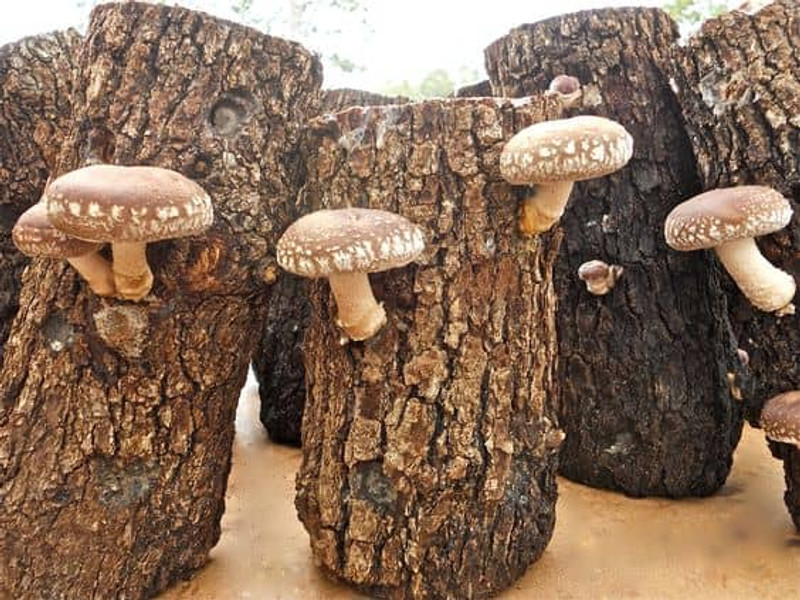Best Wood Species for Growing Mushrooms: Ultimate Guide
Posted by Troy Cosky, Founder FunGuy Grow Supply on 5th May 2023
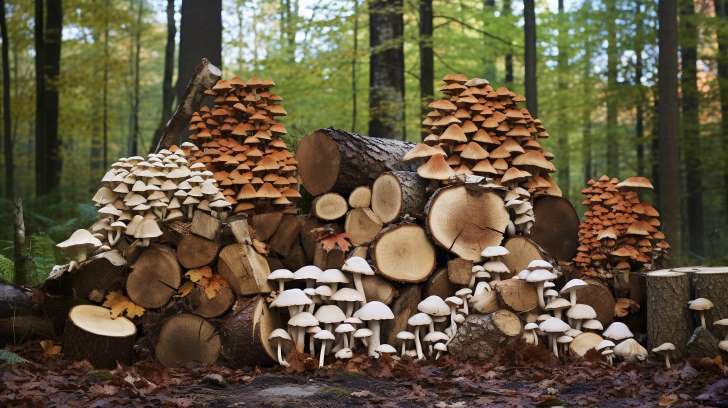
The Best Species Of Wood For Growing Mushrooms: Ultimate Guide
Are you looking to grow mushrooms? Then you need to know the best species of wood to use. In this ultimate guide, we will explore the importance of appearance in mushroom cultivation and the key considerations when choosing log varieties.
The choice of mushroom spawn and the kind of wood are fundamental factors that influence the success of your harvest. Selecting the optimal species of log is best suited for your specific mushroom variety can greatly impact the ability to produce mushrooms. Oak, cedar, or maple, known for their porous nature and rich nutrients, stand out as favored choices. Once you've inoculated the logs, it's vital to understand how to properly store your logs to maintain ideal conditions for mushroom growth, ensuring a fruitful harvest.
We will compare oak and cedar logs, focusing on their appearance. Additionally, we will discuss the importance of durability, maintenance, cost, and environmental impact. Get ready to become an expert in growing mushrooms on the best wood.
Key Takeaways
- Oak and cedar logs are among the best woods for growing mushrooms.
- Different mushroom species have specific preferences for wood types.
- Cedar logs are resistant to decay and insect infestation.
- Oak logs offer remarkable durability and can last for several years.
The Importance of Appearance in Mushroom Cultivation
When growing mushrooms, the appearance of the logs plays a crucial role in their cultivation success. Choosing the right species of wood is essential for creating the ideal environment for mushroom growth. Oak logs and cedar logs are among the best woods for growing mushrooms, as they provide the necessary nutrients and moisture retention.
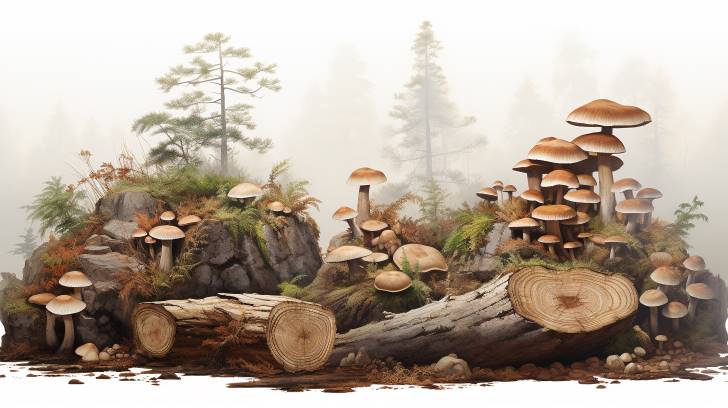
Oak logs are particularly favored for their dense and durable nature, which allows them to support the weight of the mushrooms as they grow. The natural tannins found in oak also help to deter competing fungi, ensuring a healthier mushroom crop.
Cedar logs, on the other hand, are known for their resistance to decay and insect infestation. This makes them an excellent choice for mushroom cultivation, as it minimizes the risk of contamination and ensures the longevity of the logs. Cedar logs also have a unique aroma that can enhance the overall sensory experience of growing mushrooms.
When selecting the best tree species for mushrooms you can grow, it is important to consider the specific needs of the mushroom variety you intend to cultivate. Some mushrooms have specific preferences for certain types of wood, such as shiitake mushrooms, which thrive on oak logs. Others, like oyster mushrooms, can adapt to a wider range of wood species.
Mushroom Log Varieties and Key Considerations
To determine the best log varieties for growing mushrooms, you need to consider key factors such as species compatibility, moisture content, and log age. Different mushroom species have specific preferences when it comes to the type of wood they grow on. Some mushrooms thrive on hardwood logs, while others prefer softwood logs.
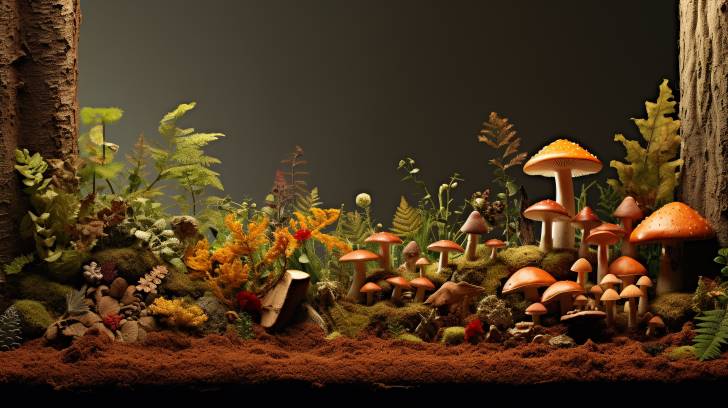
Moisture content is crucial because mushrooms require a moist environment to grow. Logs that are too dry will not support mushroom growth. On the other hand, logs that are too wet can promote the growth of competing fungi or cause the logs to rot.
Log age is also an important consideration. Freshly cut logs are often more suitable for mushroom cultivation because they have higher moisture content. However, logs that have been cut for a year or more may have undergone natural decomposition, making them more suitable for certain mushroom species.
To help you make an informed decision, here is a comparison table of some of the best woods for mushrooms:
| Wood Type | Species Compatibility | Moisture Content | Log Age |
|---|---|---|---|
| Oak | Shiitake, Maitake | Moderate | 1-2 years |
| Cedar | Oyster, Lions Mane | High | Freshly cut |
| Maple | Reishi, Turkey Tail | Moderate | 1-2 years |
| Birch | Chaga, Birch Polypore | Moderate | Freshly cut |
| Poplar | Chicken of the Woods | High | Freshly cut |
As you can see from the table, different wood types have different compatibility with various mushroom species. For example, oak logs are well-suited for growing Shiitake and Maitake mushrooms, while cedar logs are ideal for Oyster and Lions Mane mushrooms. It is also important to note that cedar logs tend to have a higher moisture content, which can be advantageous for certain mushroom species. However, the cost of cedar logs may be higher compared to other wood types. Ultimately, the choice of log variety will depend on the specific mushroom species you want to cultivate and your budget.
Species of Logs
Moving forward in our conversation about log varieties and their critical aspects, it is important to explore the different species of logs available for growing mushrooms. The choice of log species can greatly impact the success of your mushroom cultivation endeavors. Oak is one of the most popular species used for growing mushrooms due to its dense and durable nature.
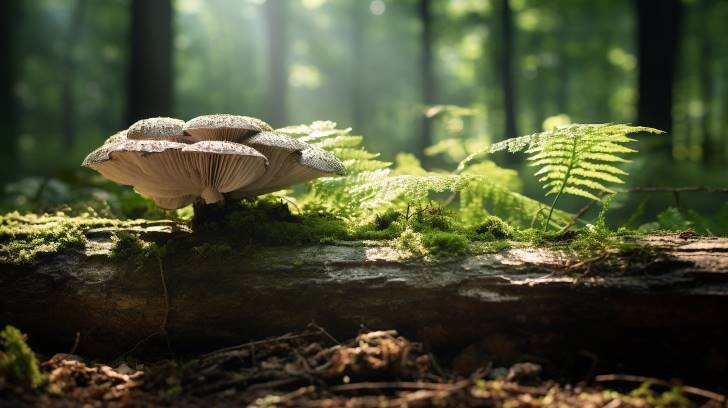
It provides a stable and long-lasting environment for mushroom growth. Maple logs, on the other hand, are known for their soft and porous wood, making them ideal for species that prefer a moist and oxygen-rich environment. Birch logs offer a balance between the two, with their moderate density and porosity.
Alder logs are highly sought after for their ability to retain water, making them perfect for cultivating mushrooms that thrive in a humid environment. Beach logs, while less commonly used, have a unique characteristic that sets them apart. They contain natural compounds that inhibit the growth of competing fungi, making them an excellent choice for mushroom cultivation.
When selecting a log species, it is crucial to consider the specific requirements of the mushroom species you intend to grow. Some mushrooms have specific preferences for certain log species, while others are more adaptable. It is always recommended to research the particular needs of the mushroom species you plan to cultivate and choose the log species accordingly.
By selecting the right log species, you can create an optimal growing environment for your mushrooms and increase your chances of a successful harvest.
Oak vs. Cedar Logs: A Comparison in Appearance
Now let's compare the appearance of oak and cedar logs for growing mushrooms. When it comes to the aesthetics of these logs, there are distinct differences to consider.
Oak logs, being made from a deciduous hardwood tree, have a rich and opulent appearance. They display a darker hue, which adds a touch of elegance to any mushroom cultivation project. The dense and strong wood of oak provides a sturdy foundation for the mushrooms to grow on, ensuring stability and longevity. The sustained fruiting period of oak also contributes to its appeal as a preferred choice for mushroom cultivators.
On the other hand, cedar logs offer a lighter and more natural aesthetic. Made from a soft hardwood, cedar has a light color that exudes a sense of purity and simplicity. The distinct aroma of cedar adds to its allure, creating a pleasant environment for mushroom cultivation. Cedar is also known for its natural resistance to rot and decay, making it a durable option for outdoor mushroom growing.
The Importance of Durability in Mushroom Cultivation
When it comes to mushroom cultivation, the durability of the wood used is crucial for the success of your project. Oak logs are known for their strength and resistance to decay, making them a durable choice for growing mushrooms.

Cedar logs, on the other hand, have a natural resistance to moisture and insects, which contributes to their durability in mushroom cultivation.
Comparing the characteristics of oak and cedar logs allows you to make an informed decision based on the level of durability required for your specific mushroom growing needs.
Characteristics of Oak Logs
Oak logs provide durability, essential for successful mushroom cultivation. The durability of oak logs is attributed to their dense and tight grain structure. This characteristic makes oak logs highly resistant to water, rot, and decay, ensuring a longer lifespan and providing a stable environment for mushroom growth.
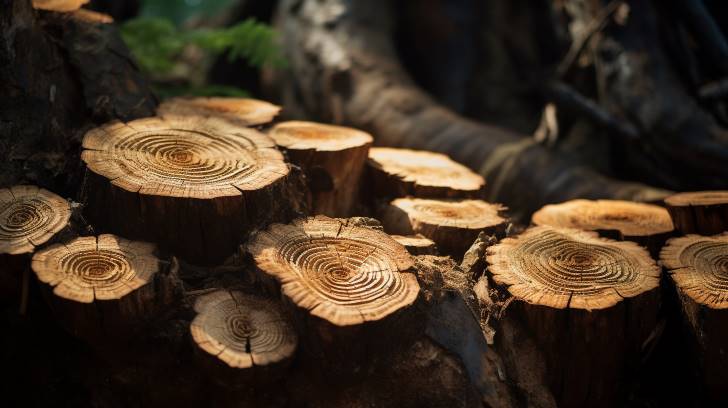
The dense grain structure of oak logs also helps in maintaining moisture levels, preventing excessive drying, and ensuring a consistent and favorable habitat for mushrooms. Additionally, the water resistance of oak logs prevents the growth of mold and fungi that may compete with or harm the cultivated mushrooms.
The durability of oak logs makes them an excellent choice for mushroom cultivation, as they can withstand the demanding conditions of the cultivation process and provide a reliable substrate for the growth of high-quality mushrooms.
Characteristics of Cedar Logs
For successful mushroom cultivation, it is essential to consider the characteristics of cedar logs, particularly their durability in providing a stable environment for mushroom growth. Cedar is a soft hardwood known for its natural resistance to decay and insect infestations.

This makes cedar logs highly suitable for mushroom cultivation as they can withstand the moist conditions required for optimal mushroom growth without rotting or succumbing to pests.
The unique aroma of cedar, derived from its natural oils, also contributes to its resistance to moisture and rot. When using cedar logs, you can expect the following benefits:
- Durability: Cedar logs are long-lasting and can withstand the test of time, allowing for multiple harvests of mushrooms.
- Stability: The sturdy nature of cedar logs ensures a stable environment for mushroom growth, providing consistent conditions for successful cultivation.
Comparison of Durability
To ensure successful mushroom cultivation, it's important to compare the durability of different wood species, as this directly impacts the longevity and stability of the growing environment. Cedar logs, although resistant to decay and insects, are prone to splitting and cracking due to their softwood nature.
On the other hand, oak logs, being a hardwood, offer remarkable durability and can withstand the test of time, making them an ideal substrate for mushroom cultivation for several years.
In terms of maintenance, oak logs require minimal upkeep, with regular monitoring for pests and rot being the primary requirement. Cedar logs, while lightweight and easy to work with, necessitate regular sealing and staining to protect against the elements and maintain their appearance.
The choice of the best wood species ultimately depends on your priorities and the level of maintenance you are willing to undertake. Now, let's move on to the next section and explore the process of preparing logs for inoculation.
Preparing Logs for Inoculation
Cutting the logs to the appropriate size and leaving the bark intact are essential steps in preparing logs for mushroom inoculation. By following these steps, you can ensure that your logs are ready to receive your preferred type of mushroom species.

Here's how to prepare your logs for successful inoculation:
- Cut the logs to the appropriate length and diameter: Logs should be cut to a size that maximizes the surface area for inoculation, typically between 3 to 8 inches in diameter and 3 to 4 feet in length. This size allows for easy handling while providing ample space for the mycelium to grow.
- Leave the bark intact: The bark of the logs contains valuable nutrients that will nourish the mycelium and promote healthy growth. Leaving the bark intact or partially removing it only in the areas where inoculation will take place ensures that the mycelium has access to these nutrients.
In preparing your logs for inoculation, it is crucial to maintain the optimal conditions for the growth of your mushrooms. Here are two additional tips to evoke emotion in the audience:
- Store the logs in a cool and shaded area: This will prevent the logs from drying out or becoming infested with pests. By protecting your logs from harsh sunlight and extreme temperatures, you are safeguarding the potential success of your mushroom cultivation project.
- Keep the logs moist and off the ground: Moisture is vital for the growth of mycelium, so regular watering or misting of the logs is necessary. Placing the logs on racks or pallets will prevent them from coming into contact with the ground, reducing the risk of contamination and infestation by pests.
Best Tree Species for Mushroom Cultivation
When it comes to selecting the best among different tree species for mushroom cultivation, it is important to consider the specific mushrooms you wish to grow. Different species of mushrooms have varying preferences for the type of wood they thrive on. For example, shiitake mushrooms prefer hardwood trees like oaks, while lion's mane mushrooms can be cultivated on both hardwood and softwood trees. By understanding the preferences of your desired mushroom species, you can choose the most suitable tree species to grow mushrooms and maximize yield.
Examples of Mushrooms That Can Be Grown on Logs
If you want to grow mushrooms on logs, choose the best tree species by considering their compatibility with different types of mushrooms. Here are some examples of mushrooms that can be grown on logs and the best tree species for their cultivation:
- Italian Oyster (Pleurotus genus):
- Best tree species: Oak, beech, poplar, willow, alder
- These trees provide the ideal conditions for the Italian Oyster mushrooms to thrive, resulting in a bountiful harvest.
- Hemlock Reishi:
- Best tree species: Hemlock, spruce, fir
- Hemlock Reishi mushrooms have a symbiotic relationship with these tree species, allowing them to grow vigorously and produce high-quality fruiting bodies.
- Lion's Mane:
- Best tree species: Hardwoods like oak, maple, beech
- Lion's Mane mushrooms prefer these hardwoods as they provide the necessary nutrients for healthy growth and development.
Choosing the right tree species for your desired mushroom cultivation is crucial to ensure successful and abundant harvests. So, make sure to consider the compatibility between the mushrooms and the tree species for optimal results.
Maintenance of Logs
To properly maintain your logs for mushroom cultivation, it is crucial to understand the characteristics of oak and cedar logs. Oak logs are known for their durability and slow decay, making them ideal for long-term mushroom production. However, they require regular watering to keep the moisture levels consistent. On the other hand, cedar logs have natural antifungal properties and are more resistant to decay. They require less watering but need to be protected from excessive sunlight to prevent drying out. By understanding these differences, you can effectively maintain your logs and ensure optimal mushroom growth.
Maintaining Oak Logs
To maintain oak logs for mushroom cultivation, you will need to follow a specific set of guidelines. Oak logs have unique characteristics that require careful attention to ensure successful fruiting.

Here are the key aspects to consider when maintaining oak logs for mushroom cultivation:
- Log Selection:
- Choose logs that are freshly cut, preferably within the last three months, as older logs may have already started to decompose.
- Select logs with a diameter of 4 to 8 inches, as this size allows for optimal colonization and fruiting.
- Log Preparation:
- Remove any loose bark and debris from the surface of the log to create a clean and sterile environment.
- Cut the logs into manageable lengths of around 3 to 4 feet, making it easier to handle and inoculate.
Maintaining Cedar Logs
Maintaining cedar logs for mushroom cultivation requires specific attention to their unique characteristics. Cedar logs are a popular choice for growing mushrooms due to their softness, which makes them easier to inoculate with mushroom spores. Additionally, cedar logs have a pleasant smell that can enhance the overall mushroom cultivation experience.
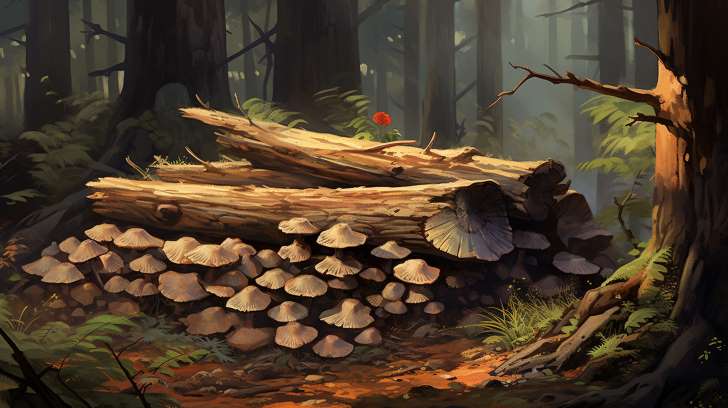
One of the key advantages of cedar logs is their natural antifungal properties, which help prevent contamination and pest infestation. However, it's important to note that cedar logs may not be as durable as oak logs and may require more frequent replacement. Regular maintenance of cedar logs is essential to ensure optimal mushroom growth.
This includes keeping the logs moist, protecting them from extreme weather conditions, and monitoring for any signs of decay or fungal growth.
Cedar Log Qualities:
- Soft and easy to inoculate
- Pleasant smell
- Natural antifungal properties
Pros:
- Easier to work with for beginners
- Natural protection against contamination and pests
- Pleasant aroma enhances the environment
Cons:
- Less durable compared to oak logs
- May require more frequent replacement
- Prone to decay and fungal growth if not properly maintained
Comparison of Maintenance Requirements
Keep logs moist and protected from extreme weather conditions to ensure optimal mushroom growth. Maintenance requirements for oak and cedar logs are similar after inoculation. Here are some steps you can take to maintain your logs effectively:
- Moisture Management:
- Regularly water the logs, especially during dry seasons, to prevent drying out.
- Keep the logs elevated off the ground using cinder blocks or wooden pallets to prevent contamination and infestation.
- Monitoring and Early Intervention:
- Regularly monitor the logs to ensure the mycelium is healthy.
- Be vigilant for signs of contamination or infection, such as discoloration, unusual smells, or the presence of mold.
- Act quickly if any signs become visually or odor prominent to prevent further damage.
Cost
Consider the affordability of oak and cedar logs when choosing the best wood for mushroom cultivation. The cost of the logs is an important factor to consider in your decision-making process. Oak logs, while more expensive than cedar logs, offer several advantages that may justify the higher price.

Oak is a deciduous hardwood tree known for its durability and longevity, making it an excellent choice for sustained fruiting periods. This is particularly beneficial for species like the Italian oyster and Hemlock Reishi, which require a longer fruiting period. Oak logs can withstand exposure to the elements better than soft hardwoods such as poplars and aspens, ensuring their longevity and reducing the need for frequent replacement.
On the other hand, cedar logs are generally less expensive than oak logs. Cedar is a softwood with a shorter lifespan compared to oak, having a sustained fruiting period of one to two years. They are ideal for species like the Pine family trees that are actually softer and preferred type of wood. Cedar logs are also easier to work with and can be easily inoculated with specific strains of mushrooms. While they may not last as long as oak logs, their lower cost and ease of use make them an attractive option for mushroom cultivation.
When considering the cost of oak and cedar logs, it is important to weigh the benefits and drawbacks of each. While oak logs may be more expensive initially, their durability and longer fruiting period may result in cost savings in the long run. On the other hand, cedar logs offer a more affordable option with easier handling and inoculation. Ultimately, your choice will depend on your specific needs and budget constraints.
Environmental Impact
To evaluate the environmental impact, it is important to analyze the sourcing and ecological implications of oak and cedar logs. When it comes to growth rate, oak trees are known for their slow growth, taking many years to mature. On the other hand, cedar trees have a faster growth rate and can be harvested sooner. This difference in growth rate can have implications for the sustainability of the logging process.

In terms of sourcing, cedar logs often come from old-growth forests, which have a significant ecological impact. These forests have developed over centuries and provide important habitats for a diverse range of species. Harvesting cedar from old-growth forests can disrupt these ecosystems and lead to the loss of biodiversity. In contrast, oak trees are typically grown in managed forests. These forests are specifically designed to support the growth of oak trees and are often managed using sustainable practices. This ensures that the logging process is carried out in a way that minimizes harm to the environment and promotes forest regeneration.
Considering the ecological implications, the sourcing of cedar logs from old-growth forests can evoke a sense of concern and sadness. These ancient forests hold a wealth of natural beauty and provide habitats for countless species. The thought of disrupting these ecosystems and potentially losing them forever can be deeply distressing. On the other hand, the sustainable sourcing of oak logs from managed forests can evoke a sense of relief and reassurance. Knowing that the logging process is carried out in a responsible manner can provide a sense of comfort and confidence in the environmental impact of using oak logs for growing mushrooms.
Conclusion
In conclusion, when choosing the best species of wood for growing mushrooms, it is important to consider the environmental impact, durability, and specific needs of your mushroom cultivation. The choice of wood species will determine the longevity of your logs, the amount of maintenance required, and the overall success of your mushroom harvest.
Oak logs are the preferred choice for their durability, as they can sustain up to four years before needing renewal. They require less maintenance and provide a stable environment for mushroom growth. However, oak logs are more expensive and have a higher environmental impact due to the longer time needed for regeneration.
On the other hand, cedar logs are a cost-effective option, making them ideal for novice or budgeted mushroom breeders. However, they have a shorter lifespan, typically requiring renewal after one to two years. Cedar logs also demand more maintenance to ensure the health of the mycelium and prevent drying out.
When selecting wood for inoculation, fresh logs that have been cut within the last six weeks are recommended to minimize the risk of contamination. It is important to leave the bark intact, as it contains essential nutrients and serves as a protective barrier against drying out.
Once the logs are inoculated, they should be kept in a cool and shaded area to promote mycelium growth and prevent drying. Regular maintenance is crucial for both oak and cedar logs to monitor the health of the mycelium and identify any potential issues or infections.
Unlock Mushroom Mastery with FunGuy Supplies
Ready to elevate your mushroom growing journey? Click to explore FunGuy Mushroom Supply for top-notch Mushroom Grow Kits, Grain Spawn, and Substrates. From beginners to experts, find everything you need for a bountiful harvest!
Frequently Asked Questions

What Are Some Common Challenges Faced by Mushroom Cultivators?
When growing mushrooms, you may encounter common challenges that can affect your cultivation process. These challenges can include maintaining proper humidity levels, controlling temperature fluctuations, preventing contamination from bacteria or mold, and managing pests that can harm the mushrooms. It is important to address these challenges promptly to ensure successful mushroom cultivation. By understanding and implementing effective techniques, you can overcome these obstacles and achieve optimal results in your mushroom growing endeavors.
Can Mushrooms Be Grown on Any Type of Wood?
Yes, mushrooms can be grown on various types of wood. Different species of mushrooms have specific preferences for the type of wood they thrive on. Some prefer hardwoods like oak or maple, while others do well on softwoods like pine or fir. It's important to choose the right wood species to provide the ideal growing conditions for the mushrooms you want to cultivate. Factors such as moisture content, nutrient availability, and the presence of certain compounds in the wood can affect the growth and yield of mushrooms.
What Factors Should Be Considered When Selecting the Best Tree Species for Mushroom Cultivation?
When selecting the best tree species for mushroom cultivation, several factors should be considered. First, the wood should be hardwood, as it provides a suitable substrate for mushroom growth. Additionally, the moisture content of the wood is crucial, as it affects the mushrooms' ability to absorb water and nutrients. The wood's pH level is also important, as mushrooms thrive in slightly acidic conditions. Lastly, the availability and cost of the wood should be taken into account, as they can impact the feasibility of large-scale mushroom cultivation.
How Long Does It Typically Take for Mushrooms to Grow on Logs?
Typically, the time it takes for mushrooms you want to grow on logs can vary depending on several factors. These factors can include the species of mushroom being cultivated, the specific conditions provided for the growth, and the type of wood used. In general, it can take anywhere from a few weeks to several months for mushrooms to appear on logs. Patience and proper care are essential in ensuring successful mushroom cultivation.
Are There Any Environmentally-Friendly Practices That Can Be Implemented in Mushroom Cultivation?
To implement environmentally-friendly practices in mushroom cultivation, there are several options you can consider. First, you can use organic and sustainable materials for growing substrates, such as straw or wood chips from sustainably managed forests. Additionally, you can reduce waste by reusing and recycling materials whenever possible. Another practice is to minimize the use of synthetic fertilizers and pesticides by opting for natural alternatives. Lastly, you can explore renewable energy sources to power your cultivation operations.
References
- Cotter, T. (2015). Organic Mushroom Farming and Mycoremediation: Simple to Advanced and Experimental Techniques for Indoor and Outdoor Cultivation. Chelsea Green Publishing. ISBN-10: 1604692707
- Shein, C. (2013). The Vegetable Gardener's Guide to Permaculture: Creating an Edible Ecosystem. Timber Press. ISBN-10: 1604692707

